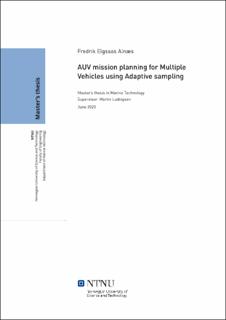| dc.contributor.advisor | Ludvigsen, Martin | |
| dc.contributor.advisor | Fossum, Trygve Olav | |
| dc.contributor.author | Alnæs, Fredrik Elgsaas | |
| dc.date.accessioned | 2021-09-21T16:28:15Z | |
| dc.date.available | 2021-09-21T16:28:15Z | |
| dc.date.issued | 2020 | |
| dc.identifier | no.ntnu:inspera:54166542:20909268 | |
| dc.identifier.uri | https://hdl.handle.net/11250/2780108 | |
| dc.description.abstract | Flere AUV-er brukes i dag i prøvetaking av havet for å studere hvordan marint liv i havet påvirkes av endringer på grunn av havfenomener som havfronter eller eddier. Havprøvetaking er ofte avhengig av forhåndsprogrammerte oppdrag. Dette er problematisk siden forkunnskap om havet vanligvis er dårlig og stadig endrer seg. Hensikten med denne oppgaven er å utvikle en algoritme og teste beslutningsmetoder for å bruke adaptiv prøvetaking ombord i flere AUV-er for å forbedre prøvetaking av havet. Adaptiv prøvetaking kan resultere i forbedret effektivitet og prøvetakingsresultater. Ved å bruke flere AUV-er samtidig og utføre et samarbeidsoppdrag med kommunikasjon, er målet å øke effektiviteten og forbedre prøvetakningsresultatene sammenlignet med flere AUV-er som kjører et forhåndsplanlagt oppdrag.
I denne masteroppgaven gjøres det 12 simuleringer av adaptiv prøvetaking ved å bruke et Python-program hjulpet av PyIMC for å kontrollere flere AUVer. AUVene simuleres ved hjelp av LSTS Toolchain. En havserver basert på data fra en SINMOD-fil brukes til å simulere havprøvetaking. Gaussiske prosesser brukes til å forutsi temperaturen i oppdragsområdet basert på havprøvetaking utført av AUVer. Som input til den gaussiske prosessen, brukes gjennomsnittet av alle tilgjengelige temperaturer fra kartreferansene i SINMOD-filen. Prediksjonen fra den gaussiske prosessen brukes som input for å teste flere myopiske beslutningsmetoder.
Simuleringsresultatene viser en forbedring i både effektivitet og kvalitet når man samler havdata. Den gjennomsnittlige absolutte feilen mellom den faktiske temperaturen og den gjennomsnittlige temperaturen som ble brukt i den gaussiske prosessen var 0,03046°C. Resultat fra adaptiv prøvetaking med to AUVer som kommuniserer, viser en gjennomsnittlig absolutt feil så lavt som 0,01410°C. Denne simuleringen kjørte i 13 timer. Den gjennomsnittlige absolutte feilen for adaptiv prøvetaking med en AUV eller to AUVer som ikke kommuniserer, var omtrent 0,020°C. Simuleringen gikk i 25 timer for en AUV og 12 timer for to.
Algoritmen presentert i denne oppgaven gjør det mulig å kartlegge et område både tidseffektivt og med en finere oppløsning. Denne algoritmen skal kunne arbeide med alle havdata. Ved å bruke gaussiske prosesser for å forutsi havdata, kan adaptiv prøvetaking utvide mulighetene for å oppdage datasett som aldri har blitt samlet før. Dette er mulig selv med lite eller ingen havdata på forhånd. Resultatene viser vellykket implementering av en beslutningsmodell for fler-AUV-systemer som gjør adaptiv prøvetaking. Utførelser i det virkelige liv må testes før dette kan sies med sikkerhet. Før bruk av algoritmen beskrevet her i en feltprøve, må noen problemer undersøkes nærmere. Det må jobbes videre med å lage en bedre kommunikasjonsmodell. Når teknologien utvikles, vil mulighetene for å bruke ikke-myopiske beslutningsmetoder sammen med mer komplekse gaussiske prosessmodeller, kunne bidra til bedre prøvetaking av havet. | |
| dc.description.abstract | Multiple AUVs are today used in ocean sampling to study how marine life is influenced by changes due to ocean phenomena's like ocean fronts or eddies. Ocean sampling often relies on pre-programmed missions. This is problematic since prior knowledge of the ocean is usually poor and constantly changing. The purpose of this thesis is to develop an algorithm and test decision methods to use adaptive sampling onboard multiple AUVs to improve ocean sampling. Adaptive sampling can result in improved efficiency and sampling results. By using multiple AUVs simultaneously and perform a cooperative mission with communication, the goal is to increase the efficiency and improve the sampling results compared to multiple AUVs running a pre-planned mission.
In this thesis, 12 simulations of adaptive sampling are done by using a Python program aided by PyIMC to control the multiple AUVs. The AUVs are simulated using the LSTS Toolchain. An ocean server based on data from a SINMOD file is used to simulate the ocean sampling. Gaussian Process is used to predict the temperature in the mission area based on the ocean sampling done by the AUVs. As an input to the Gaussian Process, the mean of all temperature grids available in the SINMOD file, are used. The prediction from the Gaussian Process is used as the input for testing several myopic decision methods.
The simulation results show an improvement in both efficiency and quality when gathering ocean data. The mean absolute error between the actual temperature and mean temperature used in the Gaussian Process was 0.03046°C. Results from adaptive sampling with two AUVs communicating show a mean absolute error as low as 0.01410°C. This simulation ran for 13 hours. The mean absolute error for adaptive sampling with one AUV or two AUVs not communicating was approximately 0.020°C. The simulation ran for 25 hours for one AUV and 12 hours for two.
The algorithm presented in this thesis makes it possible to survey an area both time-efficient and with a finer resolution. This algorithm should be able to work with any ocean data. By using Gaussian Process to predict the ocean data, adaptive sampling can broaden the possibilities to discover data sets never gathered before. This is possible even with little or no previous ocean data. The results show the successful implementation of a decision model for multi-AUV systems doing the adaptive sampling. Real-life performance has to be tested before this can be said for certain. Before using the algorithm provided here in a field test, some issues need to be looked further into. Further work needs to be done in regards to making a better communication model. As technology develops the possibilities of using non-myopic decision methods together with more complex Gaussian Process models can contribute to better ocean sampling. | |
| dc.language | | |
| dc.publisher | NTNU | |
| dc.title | AUV mission planning for Multiple Vehicles using Adaptive sampling | |
| dc.type | Master thesis | |
